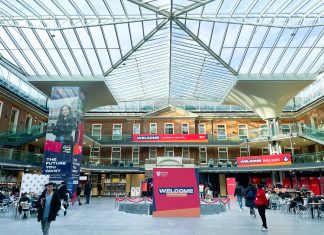1. The Globe Theatre – reviving live performances of Shakespear’s plays

The Globe Theatre, located in the London Bridge area, acts as a faithful reconstruction of the original Globe Theatre, where William Shakespeare’s plays were originally performed during the Elizabethan era. In 1997, the Globe Theatre opened its doors to the public with the aim of reviving live performance of Shakespear’s plays just 230 meters away from the original site. The reconstruction team carefully researched specific details regarding the original theatre in order to make sure that the new replica would be as similar as possible.
Due to its similarity, the Global Theatre welcomes over a million people each year who not only come to watch Shakespear’s plays but to visit the theatre itself. For the first 18 seasons, live performances were even coordinated to replicate the original circumstances: all music was performed live, there were no spotlights, and plays were staged during the day or evening only.
Source: Theatre Weekly
2. The location for a number of Dickens’s novels

The enhancing city of London is home to the locations depicted in several Dicken’s novels due to its vibrant streets and contrasting social landscapes. Dickens used London as a source of inspiration for the characters and the social critiques incorporated in his works. In fact, he believed that London “triggered his imagination” like no other place.
Throughout his work, Dickens vividly depicts the city’s bustling neighborhoods, its poverty-stricken corners, and social disparities of the city. Today, Dicken’s novels serve as educational pieces that not only showcase the power of storytelling and literary devices, but also shed light on societal issues and challenges that existed at the time in London.
Source: CNN
3. The place that the Pilgrims of Chaucer’s “Canterbury Tales” set off from

The London Bridge area is an important symbol within the literary history of the country, as it is the starting point for the pilgrims depicted in Geoffrey Chaucer’s work “The Canterbury Tales”. The location mentioned in the stories is known as the Tabard Inn, symbolizing the historic neighborhood of Southwark, where travelers were provided respite and refreshment before continuing their journeys.
Today, the legacy of the Tabard Inn and the pilgrimage’s lives are present in the London Bridge area, reminding us of the enduring power of Chaucer’s storytelling and the diverse themes explored in his works.
Source: Historic UK
4. The location of the first Roman town on the Thames two Millenia ago

The first Roman settlement on the River Thames was called Londinium, and it was situated in what is now modern-day London. Londinium, a bustling urban metropolis, was established around 43 AD following the Roman conquest of Britain.
It served as a crucial center for trade and business, connecting Roman Britain to the continent of Europe, as a strategic river crossing. Londinium’s historical significance cannot be denied, and the ruins of the city provide a window into the early Roman presence and power in the region, even though its exact boundaries are unknown.
Source: London City Break
5. Home to The Shard: an iconic skyscraper that dominates the London Bridge skyline

Located in the London Bridge area, The Shard not only dominates the area’s skyline with an impressive heigh of 310 meters (1,017 feet), but also holds the distinction of being the tallest building in the United Kingdom.
The Shard’s design is a representation of contemporary architectural excellence, characterized by modern design featuring a glass-clad façade. The building is currently used by a diverse array of purposes, including offices, luxurious residential apartments, a hotel, restaurants and a public viewing gallery. Additionally, The Shard has a series of upper floors that offer visitors the opportunity to see London through breathtaking panoramic views.
Source: The Shard










